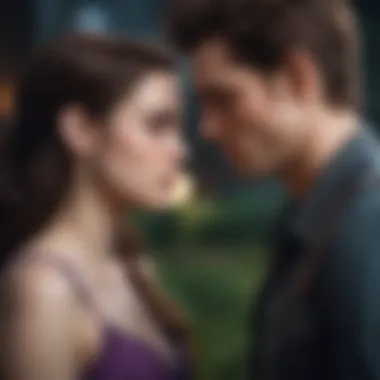Exploring the Twilight Saga: Cultural Impact and Themes


Intro
The Twilight Saga, a series that took the world by storm, has left an indelible mark on both cinema and literature. This article delves into its complexities, examining the nuances of its narrative, character arcs, and thematic currents that have resonated with audiences for over a decade. From its portrayal of love tangled in supernatural elements to its impact on popular culture, the saga serves as a riveting case study in contemporary storytelling.
At its core, the Twilight Saga revolves around the tumultuous romance between a young human, Bella Swan, and a brooding vampire known as Edward Cullen. The series, rooted in its strong narrative structure, not only entwines melodrama with fantasy but also prompts discussions around morality, sacrifice, and the essence of love itself. The later installments introduce several dynamics, such as the contrasting relationships among vampires and werewolves, further enriching the narrative landscape.
The cultural phenomenon that emerged is remarkable, and thus, the relevance of understanding this series cannot be overstated. It is not simply a tale of wooing and wooed; it encapsulates societal shifts, the evolution of fandom, and genre expectations. As we dissect this saga, we aim to uncover how these themes continue to shape discussions in film, literature, and broader societal contexts.
Overview of the Twilight Saga
The Twilight Saga marks a defining chapter in the annals of modern cinema and literature. Its significance extends beyond the pages of Stephenie Meyer's books; it paves the way for discussions around themes of love, identity, and what it means to be human in a world punctuated by the supernatural. In dissecting this phenomenon, it becomes clear that its blend of romance and fantasy resonates on multiple levels, drawing in audiences from varied backgrounds and interests.
Origins and Creation
The inception of Twilight can be traced back to 2003 when Stephenie Meyer had a rather vivid dream. The dream involved a human girl and a vampire who was both alluring and dangerous. This moment sparked a series of writings that would eventually become the franchise we know today. Meyer's unique approach to the vampire genre introduced a new archetype: the brooding vampire caught in emotional turmoil, which stood in stark contrast to the traditional, more sinister portrayals.
Not only did the Twilight series emerge from a dream, but it also caught fire largely due to the powerful synergy of Internet fandom and early social media engagement. The burgeoning online communities fostered discussions that helped gain traction, making it impossible to ignore its cultural relevance.
Synopsis of the Series
At its core, the Twilight series narrates the tumultuous romance between Bella Swan, an ordinary girl, and Edward Cullen, a vampire with a moral compass. The first book introduces readers to Forks, Washington—a sleepy town drenched in rain—a stark backdrop that mirrors the emotional weight of the story. As Bella navigates her precarious relationship with Edward, themes of choice, love, and belonging unravel.
As the saga progresses through its four novels, Bella's journey from the innocent high school girl to a mother and even a vampire reveals the complex layers of personal growth. The tension with Jacob Black, a werewolf who also harbors feelings for Bella, adds further complexity to her character arc and raises questions about loyalty, friendship, and desire. Each twist takes readers deeper into a maelstrom of emotional conflict and societal critique, allowing for a nuanced exploration of relationships—the very heartstrings of the narrative.
Cinematic Adaptations
When the Twilight novels were adapted into films, they broke new ground in visual storytelling. The first film debuted in 2008, bringing a dreamlike quality to Forks that was almost a character in itself. The casting of Kristen Stewart as Bella and Robert Pattinson as Edward was as polarizing as it was iconic, leaving an indelible mark on pop culture. The visual representation of vampires, with their sparkling skin in the sunlight, added a fresh twist that diverged from traditional lore.
Critically, the films had their share of mixed reviews; whilst many celebrated the lush cinematography and emotional depth, others criticized the performances and pacing. However, the box office figures tell a different story: the series grossed over $3.3 billion worldwide, making it a cultural juggernaut that spurred renewed interest in fantasy romance.
The Twilight Saga not only altered the landscape of young adult literature but also set off a domino effect in the film industry, paving the way for similar narratives that combine romance and the supernatural.
"Twilight is not just a saga; it’s a cultural touchstone that encapsulates the fears and desires of a generation."
In sum, the Twilight Saga has transcended its origins to become a multifaceted exploration of love, identity, and the human condition. Its origin story, epic arc, and film adaptations serve as a fertile ground for further exploration in this article, as we delve into character analysis, themes, and critical reception.
Character Analysis
In the realm of The Twilight Saga, character analysis is not merely an exercise in naming protagonists and antagonists; it is about understanding the layers that make each character resonate with audiences. Characters embody different struggles, desires, and moral choices that reflect broader societal themes. Analyzing them helps to unravel the deeper meanings of their actions and relationships, influencing not only how audiences relate to them but also how the story unfolds.
Bella Swan: The Protagonist's Journey
Bella Swan is the beating heart of the Twilight Saga, a character whose development resonates with the struggles of identity and the quest for belonging. Starting as a somewhat passive individual, she moves into a world that wants to consume her. The narrative places her in scenarios that inherently challenge her; she is torn between her human life filled with mundane concerns and the supernatural allure of the vampire world.
What makes Bella intriguing is her relatability. She's not a flawless hero; she falters, she makes choices driven by emotion rather than rationality, all of which depict her as human. Her journey symbolizes the transition from adolescence to adulthood—grappling with love, fear, and ultimately, sacrifice. Each choice she makes is a stepping stone toward understanding her own identity and the complexities of her relationships.
Edward Cullen: The Romantic Ideal
Edward Cullen represents the epitome of the romanticized vampire, deeply introspective yet endlessly alluring. He often embodies the tension between longing and restraint, playing off Bella's youthful impulsiveness. Edward's character is not just defined by his vampiric traits but by his moral compass—his choice to abstain from human blood illustrates a struggle between his desires and ethical standards.
This duality is crucial as it invites audiences to examine what "ideal" love means. In many ways, Edward becomes a mirror for Bella's own evolution. Through their interactions, readers glean insights into themes of obsession versus genuine connection:


- Love versus possession: Is Edward's desire for Bella a reflection of true love or an unhealthy obsession?
- The nature of sacrifice: How far should one go to protect a loved one?
Thus, Edward's character becomes a complex exploration of love’s brighter and darker facets, enriching the overarching narrative.
Jacob Black: The Complicated Rivalry
Jacob Black introduces a contrast to Edward's character and adds complexity to Bella's journey. As a werewolf, Jacob embodies strength and unfiltered passion, yet he grapples with the volatility of his emotions. His bond with Bella is layered; it begins with friendship but quickly evolves into an intense romantic involvement that raises questions of loyalty, consent, and the nature of true love.
Jacob's character challenges the black-and-white perceptions of heroism. While he genuinely cares for Bella, his willingness to resort to violence and manipulation casts shadows on his motives. The rivalry between Edward and Jacob enables readers to explore themes of jealousy, conflict, and the idea that love is neither simple nor one-dimensional.
"In the tale of love, passion often walks hand in hand with rivalry; it's the tension that draws one closer to the truth of one's heart."
Supporting Characters: A Broader Perspective
Beyond the primary trio, the supporting characters in Twilight enrich the narrative, offering different lenses through which to examine love, loss, and loyalty. Characters like Alice Cullen provide depth by embodying optimism and intuition, while characters such as Rosalie Hale challenge gender norms within the vampire lore. Each of these characters adds complexity to Bella's world and reflects diverse facets of human experience:
- Alice Cullen: Represents acceptance and the future, encouraging Bella to embrace her identity.
- Rosalie Hale: Her story is one of loss and betrayal, raising questions about envy and the price of beauty.
- Charlie Swan: Bella's father serves as a reminder of familial ties and grounding in reality amidst chaos.
These figures demonstrate the interconnectedness of relationships and contrast with the main characters' journeys, highlighting how everyone plays a role in shaping one another's realities.
Themes and Symbolism
The themes and symbolism in the Twilight Saga are at the crux of its storytelling, offering layers of meaning that resonate with audiences both young and old. These elements not only fuel the dramatic arcs of the characters but also reflect the complex emotional landscape relevant in contemporary society. From the dynamics of love and sacrifice to deeper existential themes of immortality and identity, the series provides a rich canvas for exploration. Just as a diamond's brilliance shines brightest from multiple angles, the interconnected themes in the Saga allow for varied interpretations and discussions, making it a continued point of interest in both literary and cinematic contexts.
Love and Sacrifice
At the heart of the Twilight narrative lies the theme of love, often juxtaposed with the notion of sacrifice. Bella's attraction to Edward is more than mere teenage infatuation; it embodies a complex interplay of desire and danger. The constant tension between personal longing and the dire consequences of their union sheds light on the lengths individuals may go for love. This is vividly illustrated during climactic points where Bella must make decisions that not only affect her own life but also those of her loved ones.
Moreover, the concept of sacrifice manifests through many characters. Edward, for instance, grapples with the vampire instinct to protect Bella even as it means distancing himself from her. In a sense, their love story is a narrative filled with what one may call "passive sacrifice"—choosing not to act out of a fear of causing harm. This thought-provoking dynamic encourages readers to reflect on the true essence of love: is it merely about finding happiness, or does it include the courage to relinquish it for another’s well-being?
Identity and Transformation
Identity plays a pivotal role within the Saga, not only concerning how individuals define themselves but how societal expectations can warp those identities. Bella's transition from a mere mortal to a vampire represents both a physical and philosophical metamorphosis. Throughout her journey, the struggle lies in reconciling her past with her new existence. The transformation challenges Bella to confront the essence of who she is—shifting from naivety to strength, from human vulnerability to supernatural power.
Similarly, Edward and Jacob serve as foils to Bella’s character. Edward’s existence as a vampire makes him grapple with his own identity, caught between his predatory nature and his love for Bella. On the contrary, Jacob embodies a different kind of struggle, fluctuating between loyalty and his wolf heritage—both are at odds with their personalities. These explorations into identity underscore a universal truth: transformation often demands a confrontation with the self, prompting a dialogue about the inherent complexities within one's nature.
Mortality and Immortality
The themes of mortality and immortality are woven intricately into the narrative fabric of Twilight. The tension between living a finite human life and the allure of eternal life is a dilemma faced by both Bella and Edward. For young adults, this theme can resonate deeply; it speaks to the vulnerability of youth while also hinting at the fantasy of lasting forever.
Edward offers Bella a peek into the eternal, yet as he shares his immortal experiences, a heavy weight of loneliness and alienation becomes evident. This poignant thread offers a platform for discussions on the allure of immortality—it is not simply about never aging, but also about the emotional and psychological consequences that come with outliving loved ones. The series raises questions that remain relevant: what does it genuinely mean to live, and what sacrifices come with the longing for eternity?
Cultural and Societal Reflections
Twilight does not exist in a cultural vacuum; it reflects broader societal issues and shifts in perceptions about love, gender roles, and social dynamics. The series emerged during a time of heightened discussions about feminism, offering a contrast between traditional romance narratives and modern alternatives. Bella's choices echo a rebellion against overtly masculine heroes and instead showcase a partnership defined by mutual respect and support.
Furthermore, the fascination with supernatural beings speaks volumes about humanity's ongoing grappling with the 'other.' The concept of vampires, werewolves, and the fantastical elements in the Twilight saga bring to light age-old discussions of acceptance, prejudice, and the nature of humanity itself. This blending of the familiar and the extraordinary serves to challenge readers to look at their own societal norms and the labels that often come with them.
"The true magic of Twilight lies in its reflection of human experience, merging love, identity, and societal structures into a captivating narrative that encourages introspection."
Through these themes and symbols, the Twilight Saga stands as a mirror to our own existence, and each character and plot twist adds a shade to the larger narrative canvas, echoing the multifaceted nature of human experience.


Critical Reception
The impact of the Twilight Saga on both the film industry and its audience cannot be overstated. Critical reception encompasses how the films were viewed by critics, box office success, and the fervent fandom that has formed around them. Understanding these elements provides insight into why the series remains relevant, even years after the last installment. Critics varied widely in their assessments, and fan responses often diverged from professional reviews, leading to a multifaceted picture of how the saga was received.
Box Office Performance
The box office performance of the Twilight Saga stands as a testament to its mass appeal. Every film in the series grossed substantial earnings, with the final entry, The Twilight Saga: Breaking Dawn – Part 2, raking in over $829 million globally. This level of success indicates not just a momentary fad, but a prolonged commercial phenomenon.
- The first film alone garnered around $392 million, setting the stage for sequels that consistently attracted large audiences worldwide.
- Additionally, the franchise has been successful in creating a brand that resonates well beyond the initial films, contributing to merchandise sales, themed events, and even tourism.
The amazing box office performance showcases how a well-crafted narrative can connect with an audience at scale. It is not just about vampires and romance; it reflects a cultural appetite for stories portraying unique relationships, often combining elements of fantasy, drama, and suspense.
Critical Reviews and Perspectives
When it comes to critical reception, the Twilight Saga has often been a polarizing subject. Reviewers have frequently flipped between condemnation and appreciation, often missing the substance that draws fans to the series.
"Although many critiques point out the narrative flaws, they often overlook the emotional weight such stories carry for dedicated viewers."
- Negative Reviews: Many critics lambasted aspects like subpar acting and questionable dialogue. For example, The New York Times criticized the series for "dull performances" and "teenage angst taken to melodrama."
- Positive Insights: Conversely, some critics argue that the series successfully captures the tumultuous nature of young love, resonating deeply with its intended teen audience. Noteworthy is how the films tread on themes of choice, sacrifice, and identity.
The disconnect between fan enthusiasm and critic reviews raises questions on what constitutes quality in cinema. Critics may view cinematic art through a rigid lens, while audiences can often embrace a work on a more personal level, leading to stark differences in perspective.
Audience Reception and Fandom
The fandom surrounding the Twilight Saga has spawned a dedicated community. Audiences have shown a remarkable ability to connect with the characters and scenarios presented in the films. This collective bond illustrates the emotional and sometimes visceral response to the narrative, going beyond mere entertainment into the realm of investment.
- Fan Communities: From fan fiction to social media discussions on platforms like Reddit and Facebook, fans have built extensive networks around shared interests in characters, plots, and themes.
- Conventions and Gatherings: Various conventions highlight the ongoing passion for the series, where fans don costumes and engage in discussions, showing that the culture is alive and well long after initial releases.
Moreover, audience reception can often skew toward a more favorable view compared to critics; fans appreciate the escapism and fantasy elements the series offers, focusing on their attachment to the characters rather than imperfect storytelling.
By examining these aspects of critical reception, it becomes clear that while the Twilight Saga may have its share of detractors, its impact on pop culture, specifically within the realm of young adult narratives, cannot be ignored.
Impact on Pop Culture
The Twilight Saga holds a distinctive place in the landscape of pop culture, having gained traction beyond just its intended audience. This phenomenon can be attributed to a multitude of factors that firmed its roots not just in literature, but also in cinema, fashion, and music. To comprehend its influence adequately, one must explore notable threads woven into its narrative and aesthetic.
Influence on Young Adult Literature
The impact of the Twilight Saga on young adult literature is nothing short of monumental. Stephenie Meyer’s series reignited interest in a genre that was promising yet somewhat fragmented. Prior to Twilight, young adult sections in bookstores generally featured standalone novels, with perhaps a few series trickling through. However, amidst the romantic tension between vampires and humans, Meyer crafted a multi-layered narrative that sparked a wave of series-centric young adult fiction.
Young readers found themselves drawn to the passionate love story, the moral dilemmas faced by its characters, and the quest for identity—a universal theme that resonates with adolescence. As a result, many authors began emulating this successful formula, leading to an increased volume of paranormal romances. Whereas the genre once seemed limited, it blossomed into a lucrative market for both publishers and authors alike, paving the way for the likes of The Vampire Diaries and Hush, Hush.
In essence, this saga did more than merely charm its readers; it opened the floodgates for future writers. The term 'Twilight effect' often gets tossed around in literary discussions, highlighting how one series can redefine a genre.
The Rise of Vampire Fiction
Before the release of the Twilight series, the vampire narrative danced in and out of trends, often overshadowed by other archetypes in horror and fantasy. However, after Bella and Edward stole the spotlight, the vampire fiction segment entered a renaissance. People clamored for tales of romance mixed with the supernatural, and suddenly, vampires were no longer just blood-sucking creatures of the night, but also alluring symbols of eternal love and moral conflict.
The intertwining of vampire lore with the complex emotions of youth created a new breed of character-driven storytelling. With titles such as True Blood and What We Do in the Shadows emerging around the same time, it was clear the vampires were back, but this time with a twist. This modern depiction prompted a reevaluation of classic vampire narratives, challenging the once-solid boundaries of horror to include heartfelt explorations of love and identity. As a result, vampire fiction isn't just hanging on the periphery anymore; it's splashed across various media formats, embracing a wider audience.
Merchandising and Branding


The Twilight Saga stands as a striking example of successful merchandising and branding. It has successfully transformed content from a simple book series into a media empire that touches almost every aspect of consumer culture. Items ranging from action figures to clothinglines inspired by characters have flooded markets.
Key to this success was the ability to create a lifestyle around the brand rather than solely relying on book sales or ticket revenues. Fans found themselves not just reading about vampires, but embodying aspects of the story—be it through fashion, makeup, or themed gatherings such as midnight releases or watch parties for film adaptations. This trend generated an avenue for community and connection, allowing people to express their fandom uniquely.
Taking a closer look at merchandise:
- Clothing and Accessories: Apparel that features iconic quotes or images resonates well with fans who wish to showcase their enthusiasm openly.
- Novelty Items: Everything from themed shot glasses to collectible posters has broadened the brand's reach.
- Online Engagement: Social media platforms buzzed with fan art, fandom pages, and even DIY crafts inspired by the series, enhancing community engagement.
This intermingling of pop culture and marketing has set the stage for other franchises to do the same, proving the efficacy of tapping into the emotional core of a story to elevate branding.
"Twilight changed not just literature, but the very sentence of how young adults could occupy stories that resonated with them, bringing them to life through imagination and identity."
In summation, the Twilight Saga's influence on pop culture is a rich tapestry woven with threads of literature, mythology, and identity, showcasing that the residue of such a multifaceted narrative endures far beyond its initial triumph. It invites not only discussion but also examination of how stories can shape and reshape societal norms, beginning with the characters many became fervently attached to.
The Twilight Legacy
The Twilight Saga stands as a towering beacon in modern cinematic history, weaving its narrative beyond just the silver screen. Its legacy, stretching far into the realms of both film and literature, manifests in various forms. The importance of this topic isn’t merely historical; it reflects current societal mores and the trends that emerge from the pop culture landscape.
As we delve into the legacy of Twilight, we see how it has shaped numerous aspects of contemporary discussions about youth, love, and the complexities of identity. The saga unearthed a multifaceted portrayal of teenage emotions—often tumultuous—offering a lens through which younger audiences could dissect their own experiences. Twilight's significance lies in its ability to resonate with the struggles of adolescence through compelling storytelling, despite critique on quality and substance.
Continued Relevance in Contemporary Discussions
Even years post its last film release, the Twilight Saga continues to fuel discourse within various circles. The themes of love, choice, and the struggle between desire and responsibility remain hot topics. Many still debate whether Bella Swan embodies a model for selfless love or whether her journey highlights the perils of codependency.
In discussions about female representation in media, Bella’s character often ignites contrasting viewpoints. Some viewers see her as a strong figure who ultimately chooses her path, while others argue she perpetuates the stereotype of the damsel in distress. The complexity of these discussions reflects changing societal norms and how our understanding of characters evolves over time.
"The power of twilight is that it captures the essence of youth's emotional turmoil while serving the varied interpretations of its audience."
Additionally, the emergence of new media, such as YouTube and TikTok, has spurred a resurgence of interest. Fans analyze and critique the series through video essays and fandom discussions, breathing new life into the saga.
Future of the Franchise
Looking ahead, the future of the Twilight franchise hangs delicately. Given the discussion surrounding reboots and adaptations in Hollywood, there's a tantalizing possibility that Twilight could find new expression. Fans await any hints about spin-offs or adaptations that dive deeper into the characters’ backstories or perhaps even alternative perspectives of the universe.
The landscape of television and streaming opens doors for revisiting beloved series, and Twilight could leverage this opportunity. With initiatives like comic adaptations and potential television series in discussions, the Twilight universe holds potential to engage a new audience while retaining its original fanbase.
Furthermore, the global trends toward diverse storytelling mean that a reimagining of the saga might better reflect contemporary societal issues, embracing more varied representations of culture and identity. This pivot could introduce a new layer of depth to the existing narrative, illustrating just how fluid and transformative pop culture can be.
As the generational torch passes to new viewers, it will be telling to see how they perceive Twilight. Can it stand the test of time, or will it be a relic of an era? Only time will tell.
Closure: Understanding Twilight's Place in Cinema
The Twilight Saga, for all its ups and downs, has carved its niche in the ever-evolving landscape of cinema and pop culture. This conclusion seeks to encapsulate how the series not only engages with its audience but also reflects broader societal themes, thereby solidifying its relevance even years after its last film's release.
In discussing the saga's importance, one cannot overlook its ability to spark discourse among various demographics. From academic analyses to casual fan discussions, its narrative structure and character dynamics provoke thought. This is significant in understanding why it resonates well with young adults, particularly those navigating the complexities of identity and relationships.
Additionally, while Twilight has faced its fair share of criticism, it has also opened doors for other works within the young adult genre. The impact it had is undeniably felt when observing the influx of supernatural-themed books and films that followed. Works such as The Hunger Games and Shadowhunters can trace their popularity back to the foundational elements that Twilight represented. This establishes a direct lineage that speaks volumes about its impact on pop culture.
Notably, the fandom surrounding Twilight holds a mirror to modern engagement with media. The social platforms that flourish today, like Reddit and Facebook, prominently feature discussions and communities dedicated to dissecting its every detail. This further connects Twilight's legacy to contemporary audiences who may find themselves deeply enamored with the intricate relationships among its characters. Here, the lines blur between viewer and participant, elevating fandom into a collaborative art form of sorts, where interpretations thrive independently of the original material.
Another element worth considering lies in the film adaptations themselves. The choices made in casting, directing, and even editing shape how the story is interpreted by viewers. The choice of Robert Pattinson as Edward Cullen, for instance, turned into an unexpected phenomenon—ultimately creating a sort of cultural capital around the actors involved. This ripple effect demonstrates how film can triumph as an art form by eliciting emotional responses, even if the narrative seems simple on the surface.
Ultimately, the Twilight Saga reveals the intricate relationship between audience and narrative while fostering discussions that go beyond simple enjoyment of a story. It raises questions about love, identity, and the bonds that form in extraordinary circumstances. By examining its impact on cinema and pop culture, one can appreciate that Twilight is not just a tale about vampires and romance but a reflection of societal changes, cultural dialogues, and a mirror to the insecurities and desires of its time.
"Twilight is a lens through which we can explore our own identities and the narratives we build around them."
In closing, understanding Twilight's place in cinema requires one to look beyond the story itself, into the realms of cultural significance and influence—a task that, though complex, unveils just how impactful a story can be.







